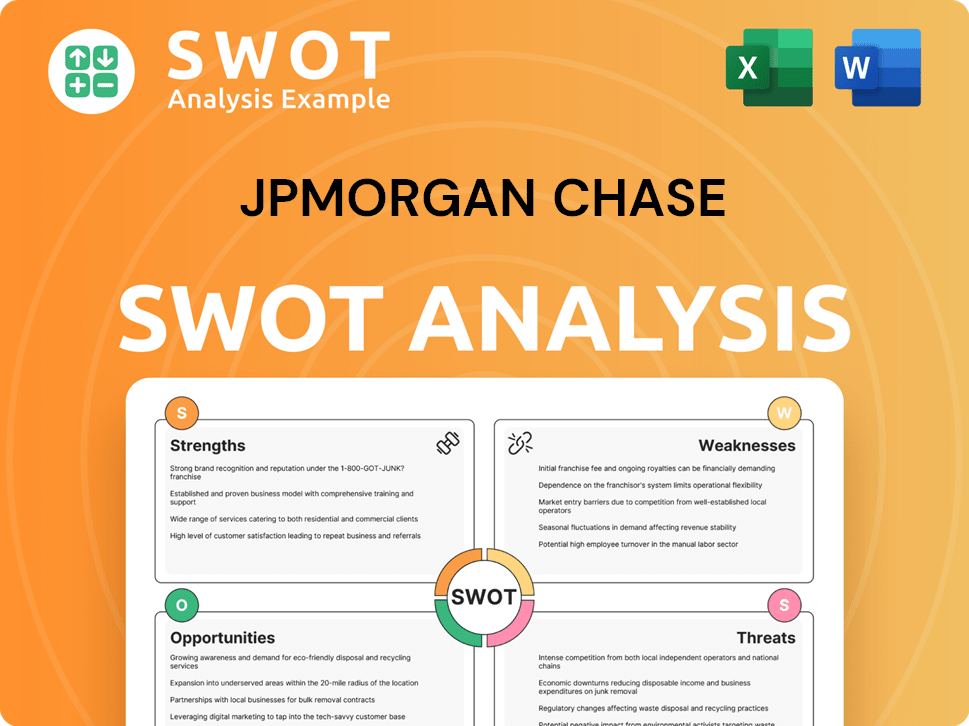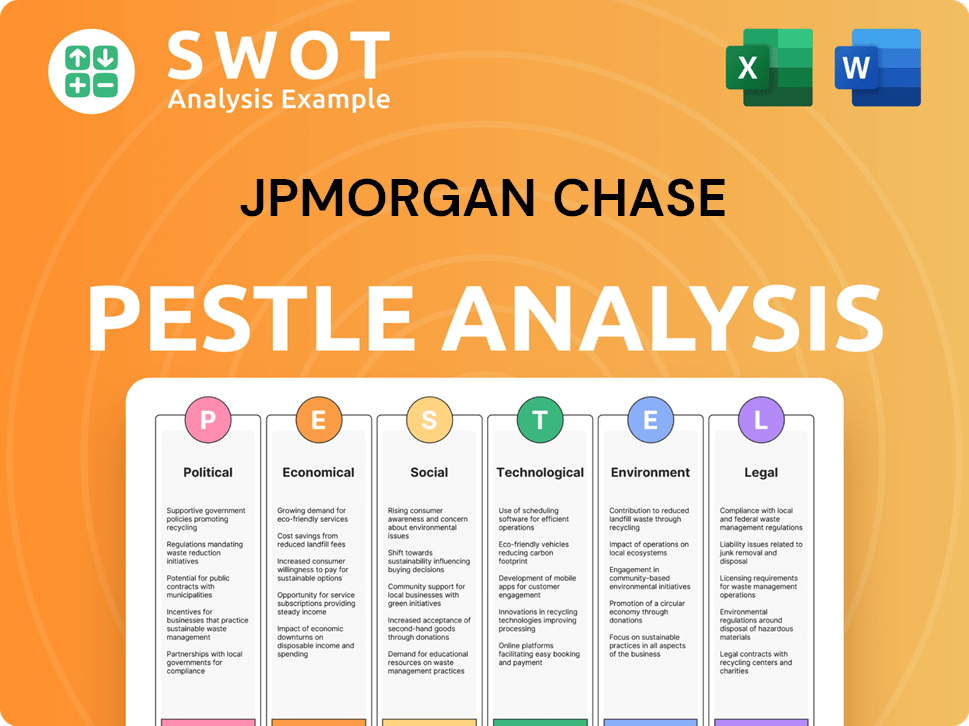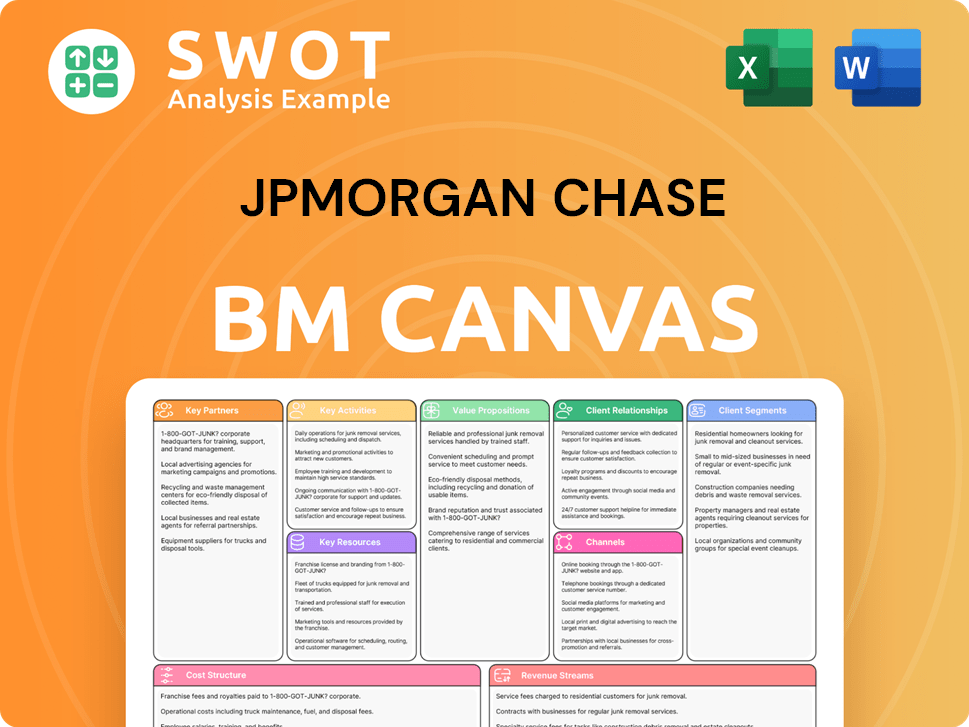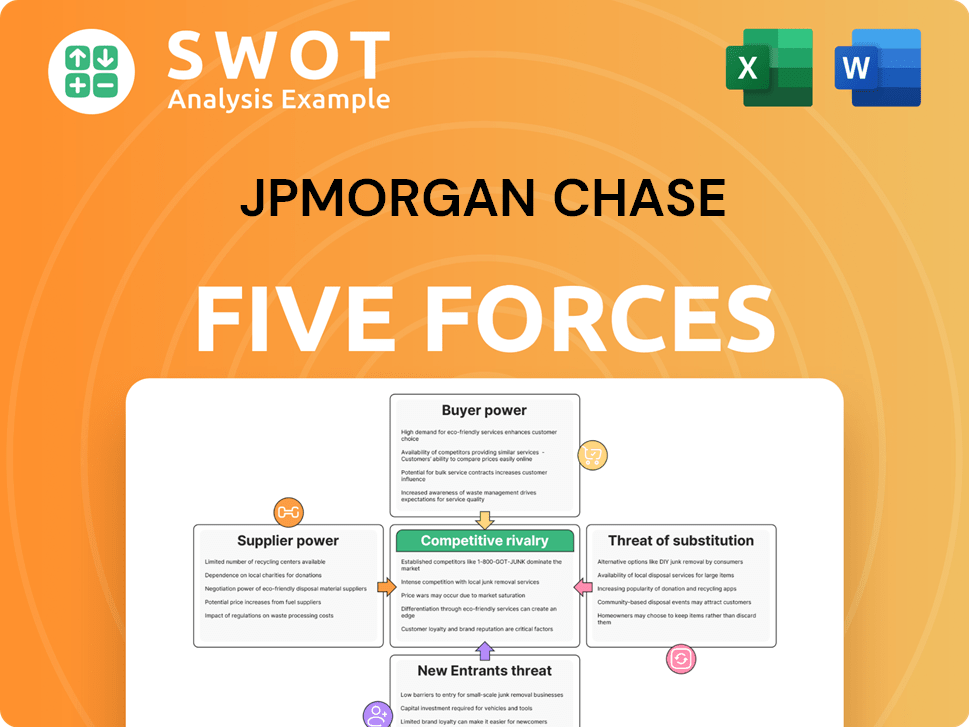JPMorgan Chase Bundle
How Did JPMorgan Chase Become a Global Financial Powerhouse?
Journey back in time and uncover the fascinating JPMorgan Chase SWOT Analysis! From its humble beginnings in 1799, this financial institution has evolved into a global titan. Explore the pivotal moments and strategic decisions that shaped the JPMorgan Chase company we know today.

The banking history of JPMorgan Chase history is a compelling narrative of innovation and adaptation. This article will delve into the early history of JPMorgan Chase, tracing its evolution through significant mergers, acquisitions, and periods of economic turmoil. Discover the key events that have solidified its position among the world's leading financial institutions.
What is the JPMorgan Chase Founding Story?
The story of JPMorgan Chase's founding is a blend of two separate, yet eventually connected, financial histories. One path began in the late 1700s with a bank designed to solve a city's water problem. The other emerged in the late 1800s, shaped by a prominent financier who helped fund the growth of American industry.
These two distinct origins, over time, merged through various acquisitions and strategic moves. This convergence led to the creation of the modern JPMorgan Chase & Co., a global financial powerhouse. Understanding these roots provides insight into the company's evolution and its enduring impact on the financial landscape.
The early JPMorgan Chase history begins with The Bank of the Manhattan Company, established on September 1, 1799, in New York City. Its initial purpose was to provide a central water supply for the city's residents. However, its charter included provisions for banking, which led to the establishment of the Bank of the Manhattan Company.
- Aaron Burr, a significant American politician, was the primary founder of The Bank of the Manhattan Company.
- The bank offered essential services like savings accounts and commercial loans, establishing a strong financial base.
- The water company itself ceased operations in 1842, but the bank continued to thrive for over 150 years.
Separately, the JP Morgan side of the firm started in 1871 when J. Pierpont Morgan co-founded Drexel, Morgan & Co. in New York City. J.P. Morgan later launched the House of Morgan on 23 Wall Street, aiming to provide commercial, investment, and private banking services.
- The firm became known for identifying profitable American investments, especially in the expanding railroad system.
- J.P. Morgan played a crucial role in financing American industry.
- These two entities, the Bank of the Manhattan Company and J.P. Morgan & Co., eventually merged.
- Through mergers and acquisitions, they formed the modern JPMorgan Chase company. For more information on the company's ownership, you can read about Owners & Shareholders of JPMorgan Chase.
JPMorgan Chase SWOT Analysis
- Complete SWOT Breakdown
- Fully Customizable
- Editable in Excel & Word
- Professional Formatting
- Investor-Ready Format

What Drove the Early Growth of JPMorgan Chase?
The early growth and expansion of JPMorgan Chase, a story of strategic mergers and pioneering services, began with its predecessors. The evolution of the company involved significant acquisitions and mergers that shaped its global presence. These key events transformed the financial landscape, establishing it as a leading financial institution.
The Chase Manhattan Bank emerged from the merger of the Bank of the Manhattan Company and Chase National Bank in 1955. Chase National Bank, founded in 1877 by John Thompson, was a major player in the American banking sector. This merger was a pivotal step, significantly broadening their operational scope both nationally and internationally, setting the stage for its global leadership.
J.P. Morgan & Co., established in 1871, played a crucial role in commercial, investment, and private banking. It was instrumental in financing major industrial consolidations, including the formation of U.S. Steel in 1901, the world's first billion-dollar corporation. In 1959, J.P. Morgan merged with Guaranty Trust Company of New York, forming Morgan Guaranty Trust Company.
Under David Rockefeller's leadership during the 1970s and 1980s, Chase Manhattan became a leader in syndicated lending, treasury and securities services, credit cards, mortgages, and retail financial services. This period marked significant expansion and diversification of its financial services, solidifying its position in the global market. The strategic moves enhanced its capabilities and market share.
The merger of J.P. Morgan & Co. and Chase Manhattan Corporation in December 2000 created JPMorgan Chase & Co., combining two powerful institutions. The 2004 acquisition of Bank One, which brought in current CEO Jamie Dimon, added over 5,300 branches. JPMorgan Chase has a significant global presence, with operations in over 60 countries and serves millions of customers worldwide. For more details, you can read about the Revenue Streams & Business Model of JPMorgan Chase.
JPMorgan Chase PESTLE Analysis
- Covers All 6 PESTLE Categories
- No Research Needed – Save Hours of Work
- Built by Experts, Trusted by Consultants
- Instant Download, Ready to Use
- 100% Editable, Fully Customizable

What are the key Milestones in JPMorgan Chase history?
The JPMorgan Chase history is a narrative of strategic growth, marked by pivotal moments that have shaped its evolution into one of the world's leading financial institutions. From its early beginnings to its current status, the JPMorgan Chase company has navigated through various economic cycles, making strategic decisions that have solidified its position in the global financial landscape. Examining the early history of JPMorgan Chase provides crucial insights into its foundational principles and the influences that have guided its trajectory.
| Year | Milestone |
|---|---|
| 1871 | J.P. Morgan & Company is founded by J.P. Morgan, establishing the firm's presence in the financial world. |
| 1958 | Chase Manhattan Bank introduces the Chase Manhattan Charge Plan, a precursor to modern credit cards. |
| 2000 | The merger of JPMorgan Chase & Co. and The Chase Manhattan Corporation creates JPMorgan Chase & Co., marking a significant consolidation in the banking sector. |
| 2008 | JPMorgan Chase acquires Bear Stearns and the banking operations of Washington Mutual during the financial crisis, expanding its market presence. |
| 2023 | JPMorgan Chase acquires the assets of First Republic Bank, further consolidating its position in the banking sector. |
| 2024 | JPMorgan Chase achieved its highest-ever annual profit, demonstrating robust financial performance. |
JPMorgan Chase has consistently been at the forefront of innovation in the financial sector. The firm's commitment to technological advancements is evident through its digital banking services and expanded ATM network, enhancing customer experience. Recent innovations include the unveiling of their Embedded Finance solution for Walmart Marketplace sellers in Q1 2025, demonstrating a focus on integrating financial services into e-commerce platforms.
In 1958, Chase Manhattan Bank launched the Chase Manhattan Charge Plan, one of the banking history's early credit card initiatives.
JPMorgan Chase has invested heavily in digital platforms, offering online and mobile banking solutions to enhance customer convenience and accessibility.
The expansion of its ATM network has improved customer access to banking services, providing convenience and accessibility.
In Q1 2025, JPMorgan Chase unveiled its Embedded Finance solution for Walmart Marketplace sellers, streamlining fund management within the platform.
JPMorgan Chase expanded its agreement with PayPal for merchant acquiring in the UK and European markets, broadening its reach.
The firm is expanding its branch network, including plans to open approximately 50 new branches and hire 300 new employees in the Delaware Valley region.
Despite its successes, JPMorgan Chase has faced several challenges throughout its history. The 2008 financial crisis tested the firm, leading to scrutiny over risk management practices and acquisitions of distressed institutions like Bear Stearns and Washington Mutual. More recently, the 2023 banking crisis saw JPMorgan Chase acquiring First Republic Bank, highlighting ongoing market volatility. The firm's strategic responses, such as the 1935 spin-off of its investment-banking operations, leading to the founding of Morgan Stanley, demonstrate its adaptability.
The 2008 financial crisis significantly impacted financial institutions, including JPMorgan Chase, which acquired Bear Stearns and Washington Mutual to stabilize markets.
The firm faced increased scrutiny over its risk management practices, particularly during and after the 2008 financial crisis.
In 2023, JPMorgan Chase acquired the assets of First Republic Bank, underscoring the ongoing challenges in the banking sector.
JPMorgan Chase has had to adapt to evolving regulatory landscapes, including those introduced after the 2008 financial crisis.
JPMorgan Chase has navigated periods of significant market volatility, requiring strategic adjustments to maintain stability and profitability.
In 1935, JP Morgan spun off its investment-banking operations, leading to the creation of Morgan Stanley, which reshaped the firm's structure.
For more insights into the company's strategic positioning, consider exploring the Target Market of JPMorgan Chase.
JPMorgan Chase Business Model Canvas
- Complete 9-Block Business Model Canvas
- Effortlessly Communicate Your Business Strategy
- Investor-Ready BMC Format
- 100% Editable and Customizable
- Clear and Structured Layout

What is the Timeline of Key Events for JPMorgan Chase?
The JPMorgan Chase history is marked by significant milestones. This includes the founding of its earliest predecessor, the Bank of the Manhattan Company, in 1799, and the establishment of Drexel, Morgan & Co. in 1871 by J.P. Morgan. The Chase National Bank was founded in 1877. Key mergers, such as the 1955 union of Chase National Bank and The Bank of the Manhattan Company, and the 2000 merger of J.P. Morgan & Co. with Chase Manhattan Corporation, shaped the modern financial institution. Significant acquisitions during the 2008 financial crisis, including Bear Stearns and Washington Mutual, and the 2023 acquisition of First Republic Bank's assets, further defined its trajectory. In Q1 2025, JPMorgan Chase reported net income of $14.6 billion, with total assets reaching $4.358 trillion.
| Year | Key Event |
|---|---|
| 1799 | The Bank of the Manhattan Company, an early predecessor of JPMorgan Chase, was founded in New York City. |
| 1871 | J.P. Morgan and Anthony Drexel established Drexel, Morgan & Co. in New York, later renamed J.P. Morgan & Co. |
| 1877 | John Thompson founded Chase National Bank. |
| 1955 | Chase National Bank merged with The Bank of the Manhattan Company, forming The Chase Manhattan Bank. |
| 1959 | J.P. Morgan merged with Guaranty Trust Company of New York, creating Morgan Guaranty Trust Company. |
| 1996 | Chemical Bank of New York acquired Chase Manhattan Bank, retaining the Chase name. |
| 2000 | J.P. Morgan & Co. merged with Chase Manhattan Corporation to form JPMorgan Chase & Co. |
| 2004 | JPMorgan Chase acquired Bank One Corp., expanding its retail banking presence. |
| 2008 | During the financial crisis, JPMorgan Chase acquired Bear Stearns and Washington Mutual. |
| 2023 | JPMorgan Chase acquired the assets of First Republic Bank. |
| 2024 | The firm reported a record $54 billion profit for the year. |
| Q1 2025 | JPMorgan Chase reports net income of $14.6 billion, with total assets reaching $4.358 trillion. |
JPMorgan Chase is concentrating on key areas, including the implications of easing global policy and the impact of AI across industries. The firm is also focusing on regulatory changes, infrastructure investment, and the energy transition. These strategic moves are designed to position the company for future growth.
As of March 2025, JPMorgan Chase maintains a 'fortress balance sheet' with $351 billion in stockholders' equity. This financial strength supports the firm's ability to navigate market fluctuations and invest in strategic opportunities. The firm's robust financial position is a key factor in its long-term strategy.
JPMorgan Chase is heavily investing in technology, recognizing its transformative potential. A significant portion of small businesses are planning to integrate AI applications. The firm's emphasis on technology is aimed at enhancing efficiency, improving customer experiences, and driving innovation across its operations.
The firm is committed to achieving net-zero emissions by 2050, with ongoing green financing targets. JPMorgan Chase aims to shape financial policies through strategic partnerships that benefit consumers and businesses. These initiatives highlight the company's commitment to sustainability and collaborative growth.
JPMorgan Chase Porter's Five Forces Analysis
- Covers All 5 Competitive Forces in Detail
- Structured for Consultants, Students, and Founders
- 100% Editable in Microsoft Word & Excel
- Instant Digital Download – Use Immediately
- Compatible with Mac & PC – Fully Unlocked

Related Blogs
- What is Competitive Landscape of JPMorgan Chase Company?
- What is Growth Strategy and Future Prospects of JPMorgan Chase Company?
- How Does JPMorgan Chase Company Work?
- What is Sales and Marketing Strategy of JPMorgan Chase Company?
- What is Brief History of JPMorgan Chase Company?
- Who Owns JPMorgan Chase Company?
- What is Customer Demographics and Target Market of JPMorgan Chase Company?
Disclaimer
All information, articles, and product details provided on this website are for general informational and educational purposes only. We do not claim any ownership over, nor do we intend to infringe upon, any trademarks, copyrights, logos, brand names, or other intellectual property mentioned or depicted on this site. Such intellectual property remains the property of its respective owners, and any references here are made solely for identification or informational purposes, without implying any affiliation, endorsement, or partnership.
We make no representations or warranties, express or implied, regarding the accuracy, completeness, or suitability of any content or products presented. Nothing on this website should be construed as legal, tax, investment, financial, medical, or other professional advice. In addition, no part of this site—including articles or product references—constitutes a solicitation, recommendation, endorsement, advertisement, or offer to buy or sell any securities, franchises, or other financial instruments, particularly in jurisdictions where such activity would be unlawful.
All content is of a general nature and may not address the specific circumstances of any individual or entity. It is not a substitute for professional advice or services. Any actions you take based on the information provided here are strictly at your own risk. You accept full responsibility for any decisions or outcomes arising from your use of this website and agree to release us from any liability in connection with your use of, or reliance upon, the content or products found herein.